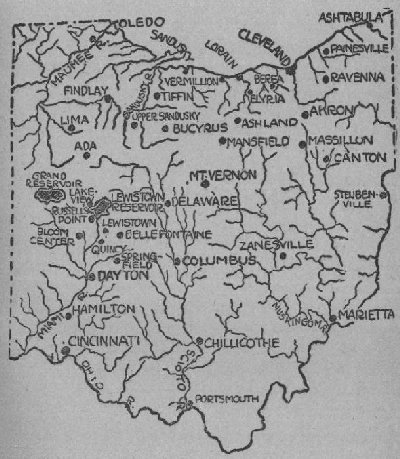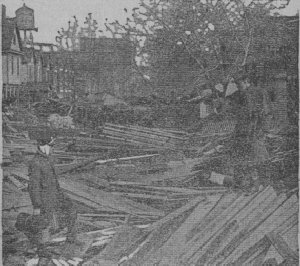STORY OF AN EYEWITNESS
PRESS CORRESPONDENT’S EXPERIENCE AT COLUMBUS— FROM SKY SCRAPER WINDOW WATCHED LEVEE MELT AWAY—FIVE STORY BUILDINGS TOPPLED INTO FLOOD.
Glenn Marston, a newspaper correspondent, was an eyewitness to the initial scenes in the great flood disaster at Columbus, O. His story of the events that filled two nights and days with horror is as follows:
Imagine yourself at the top of a perfectly safe skyscraper looking over ninety square miles of water punctured by thousands of homes—l5,000 or 20,000, at least —swirling water carrying them away one by one, or sometimes literally in swarms, and you will have some conception of what we saw in Columbus Tuesday and Wednesday. Bridges crashed at our feet—a new one every hour.
With our field glasses we could see thousands of people on roofs and in windows as effectively cut off from the world as they would have been in the moon.
They were absolutely helpless. So were we. No boat could live a moment in the rushing current, which took houses, bridges, railway tracks, telegraph poles— everything—in its overwhelming sweep.
There were 50,000 people living in this area the day before. The refugees reporting to the city hall numbered about 1,500. There were supposed to be about 5,000 on a hilltop on the west edge of the city. The rest were still clinging to housetops, trees and poles in the isolated area.
To add to the horrors of Tuesday fire broke out in half a dozen places. Nothing but the water-soaked roofs saved the district. Some of the burning houses were in water to the second story, and so the flames, while destructive enough where they started, could not spread far. The fire department was helpless. There were billions of gallons of water and not a drop which could be used. Many of the fires could not be approached closely enough to determine their exact location.
Meanwhile people were fleeing to the city hall—those lucky enough to get away. I led one poor soul, clad in a calico wrapper, with a 5-year-old boy held by one hand and a bible in the other. She knew nothing of her husband and nobody could help her.
 |
Considering the conditions, the efficiency of the relief work was astounding. Every refugee was told to report to the city hall. Here the name was entered on a blue card, which also contained the home address, the names of the relatives for whom the refugees was looking, the address to which the refugee was sent, and the amount of clothing and number of meal tickets allotted. The search for missing ones was greatly simplified by the cross indexing of the names.
But still there were thousands marooned on the west side. The bridges were all out but one. The prisoners in the workhouse had to be removed. The penitentiary was six to ten feet under water. New fires were breaking out, not dangerous, as it turned out, but enough to completely upset already overwrought nerves.
As I stood in my skyscraper window, I saw the levee which protected the entire west side, suddenly melt into the river. I saw a dozen men, linemen from the telegraph companies, apparently, struggle to keep the poles up. It was hopeless. As I was looking, the poles began to drop.
One struck a group of linemen, the connecting wires felling them in all directions. One went into the water. He was not seen afterward.
The great Pennsylvania four-track right of way, part of the finest roadbed in America, melted away like salt. The tracks on the west side of Columbus looked like a handful of tangled string thrown into a puddle.
Then came the panic. Wednesday afternoon the word started somewhere that the great fifty-foot-high storage dam five miles up the Scioto had given way. If it was so 25,000,000,000 cubic feet of water was coming. A half-crazy negro rushed into the Chittenden and shouted, "The dam’s out! Everybody get on high ground!"
 Newspaper Enterprise Association 1913 |
People went crazy. In three seconds the lobby was cleared of its 150 occupants. Three minutes after the alarm, there were 6,000 people in the statehouse, most of them struggling for the dome. Of all places!
But the dam had not gone out. It was hours before things were back to the normal abnormality of relieving the refugees and rescuing those imprisoned. The panic had even reached the boatmen who had just begun to venture among the wrecked houses.
The city was without trains, without telegraph, without telephone service, without lights or street cars and without water. The city light plant would leave the streets in darkness for weeks. The first to recover from the disaster was the Railway and Light company. It had lights burning again in fifteen minutes, though all users were requested to economize in using electricity. Twenty cars were running two hours later.
Those who could afford mineral waters could drink in safety. Those who could not had to go thirsty or take chances of infection from any kind of disease. There were three or four elevators working, none in the hotels.
When I left Columbus Thursday the loss of life was estimated between 500 and 1,000. Half the houses on the west side had toppled over or been carried away completely. Nearly all of these contained people who tried to swim to other houses.
Many could not swim, and many who could swim were swept under by the current. One could only get an idea of the strength of that raging flood when the great bridges, weighing hundreds of thousands of pounds, floated down stream hundreds of feet before sinking out of sight. Imagine trying to swim! Imagine trying to row a park skiff!
It was only Thursday that the boats began to pick up bodies. Boats which had carried these same people on pleasure jaunts last summer had turned themselves into funeral craft. A head which had lain on soft cushions and looked up into some loved one’s face, now lay stark and staring, uncushioned, bound for the undertaker. A ghastly work for picnic boats!
There was an attempt made to fight one fire. The firemen crossed the Broad street bridge, carrying their hose with them; then they had to thread their way along the eighteen-inch core wall of the levee, which had not gone out at this point. By stringing two blocks of hose they were able to reach the fire.
Every man who crossed that bridge took his life in his hands. Every man who stepped on that core wall knew that his weight might be enough to make it give way and send him and his companions to eternity.
Ten feet from the end of the bridge a group of five-story buildings had toppled over into the current a half hour before. After an hour’s weary work the hose was stretched and a stream of water came from the nozzle. It lasted a few seconds and then died to nothing. That was the moment when the water had put out the last fire in the boiler room of the water works,
Of course the railroads were in a terrible state. At the Union station there were dozens of through trains which could neither go forward nor backward. The passengers all united in praising the companies for the treatment they received. Every passenger was fed and all berths in every Pullman car were made up each night. For those who could not sleep in the cars, the railroads provided other quarters without expense to the passengers.
The train I took was the first one to Chicago. We got in 71½ hours late. In order to get this train, we had to be transferred from the city to the prairie far outside of the city. It was a drive of several miles. There, out in the open, lay a train. The locomotive had to run backward for some time, and meanwhile the passengers had to wrap up in overcoats and stamp around to keep warm, for there was no steam, and the thermometer was hovering around the freezing point.
We had, in order to get to this train, which was on the west side of the river, to cross a bridge at Fifth avenue, the only bridge left standing by which most of the west side could be reached. As we pulled out there was a constant stream of wagons going across, carrying food and clothing to the sufferers. But when I reached Toledo, I read that this bridge, the last link between the sufferers and the safe part of the city, had gone out. We were lucky to get away when we did, and luckier still that the bridge did not go down when we were on it.
All morning, relief wagons and automobiles had been rushed across at top speed. The bridge began to show weakness then, and soldiers were stationed at each end. They cut down all vehicles to a walking pace and allowed only two at a time to cross. Apparently even this light load was sufficient to jar the supports of the bridge until it tired of its work and sunk to rest with its companions in the bed of the river.
The district that was most damaged was called the "old river bed," because of a belief that the river once flowed over a mile west of where the channel now is. This area had thirty to forty feet of water over it in some places. Two-story houses floated down as if they were chips.
West Broad street, the main east and west thoroughfare, was a scene of heart-rending desolation. Far out stood a half submerged street car which was abandoned by its crew when the levee broke. In places the street was completely filled with floating houses and wreckage.
I have seen fires, floods and avalanches before, but nothing to compare with this. There is nothing in one’s imagination to compare to such a disaster. One must go through it. There was a hotel full of people without any conveniences whatever—back to the primitive—and yet there was never a murmur of discontent—the sights and sounds across the river so dwarfed our petty inconveniences that we forgot them—considered ourselves lucky to be alive. We at least had a roof and good food, even though there was five feet of water in the basement.
Continue
Back
Back to Legacy